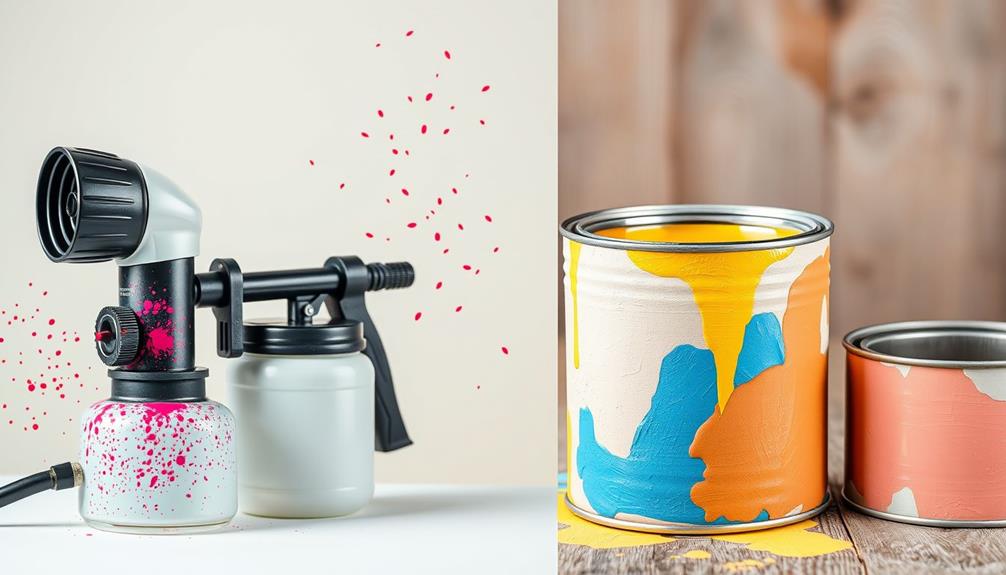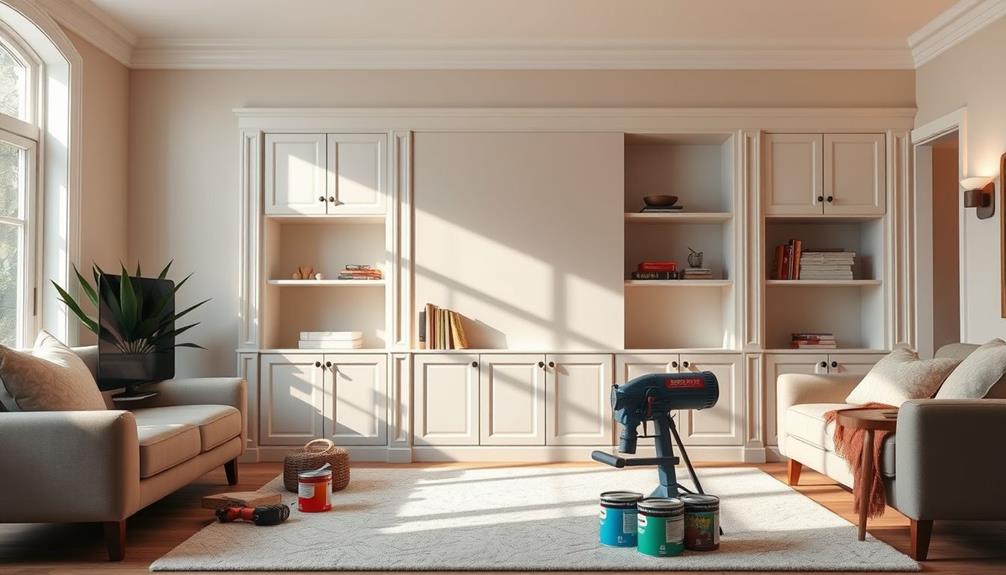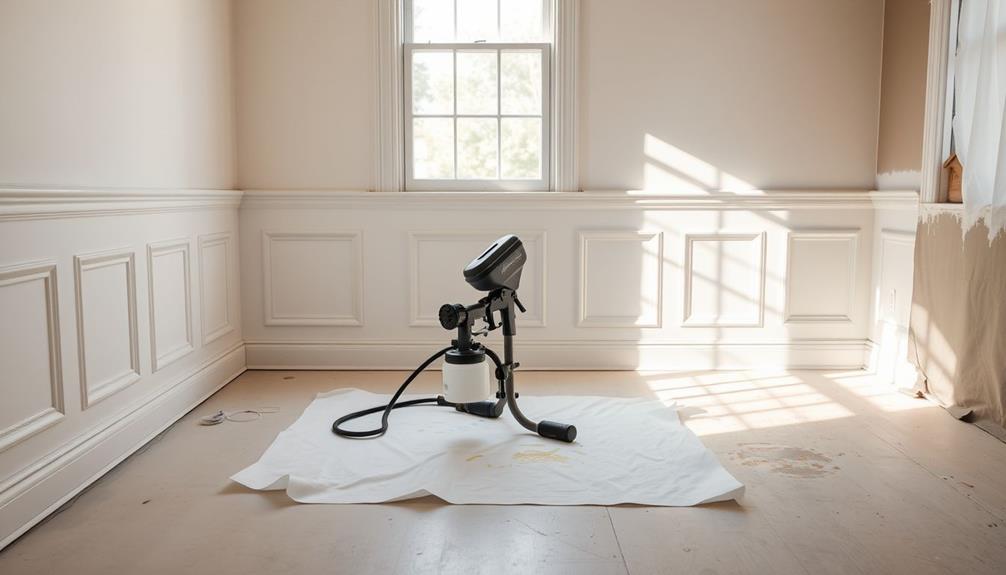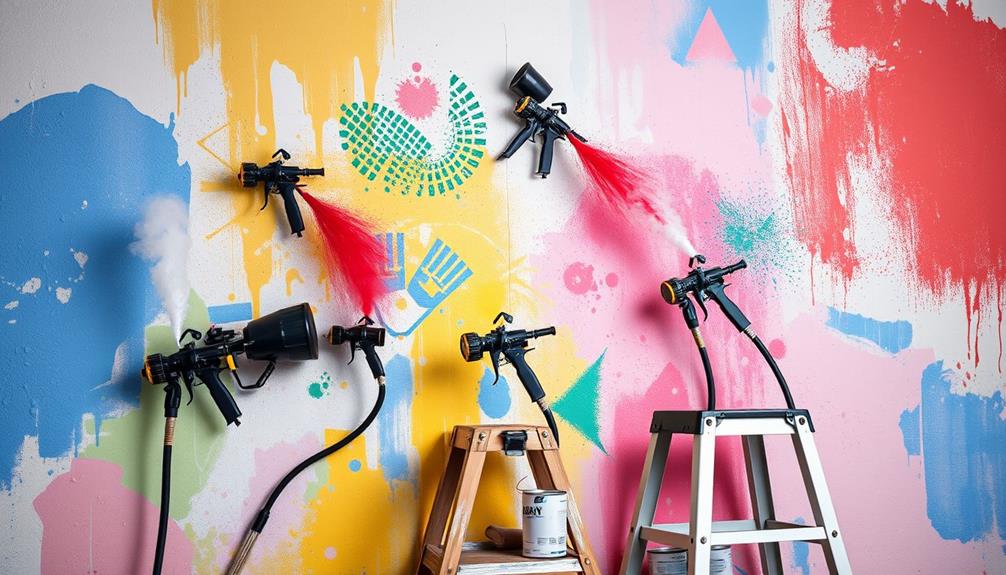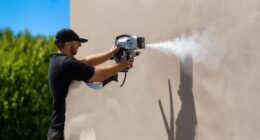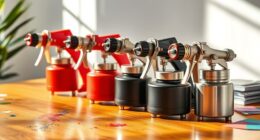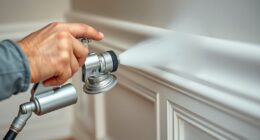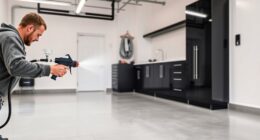When choosing between an airless paint sprayer and traditional paint brushes, it really depends on your project. Sprayers excel in covering large areas quickly, providing a smooth finish without brush marks. However, they can waste more paint and require extensive prep work. On the other hand, brushes offer precision and control, perfect for detailed work, but they're time-consuming and can leave marks. If you need efficiency for big jobs, go with a sprayer. For small, intricate tasks, brushes might be your best bet. Discover more insights to narrow down your choice effectively!
Key Takeaways
- Airless sprayers apply paint significantly faster than traditional brushes, completing jobs in half the time but consuming about 33% more paint.
- Traditional brushes offer precise control for detailed work, making them ideal for intricate areas and minimizing overspray.
- Airless sprayers achieve a smoother finish, enhancing aesthetics, while brushes may leave visible marks if not used carefully.
- Extensive preparation and cleanup are required for airless sprayers, while brushes demand minimal prep and simpler cleanup.
- Cost considerations vary, as sprayers have higher initial costs but can reduce labor expenses, making them more cost-effective for larger projects.
Overview of Painting Methods
When it comes to painting, you've got a choice between airless paint sprayers and traditional paint brushes, each with their own strengths.
Airless paint sprayers excel in efficiency, allowing you to cover large areas quickly, making them perfect for bigger projects. They deliver a smooth, even finish without the visible brush marks that often come with brush painting. This modern aesthetic is appealing, especially if you're after a sleek look.
Additionally, airless sprayers are ideal for both interior and exterior projects, providing versatility for various painting needs. For best use, specific techniques are essential to master with sprayers.
On the flip side, brush painting offers greater precision and control, which is essential for detailed work and intricate areas.
While sprayers may use about 33% more paint due to the atomization process, brushes are generally more economical regarding paint consumption for smaller jobs.
It's worth noting that quality airless sprayers might require a higher initial investment, starting around $200, compared to the lower upfront costs of brushes and rollers.
Advantages of Airless Sprayers
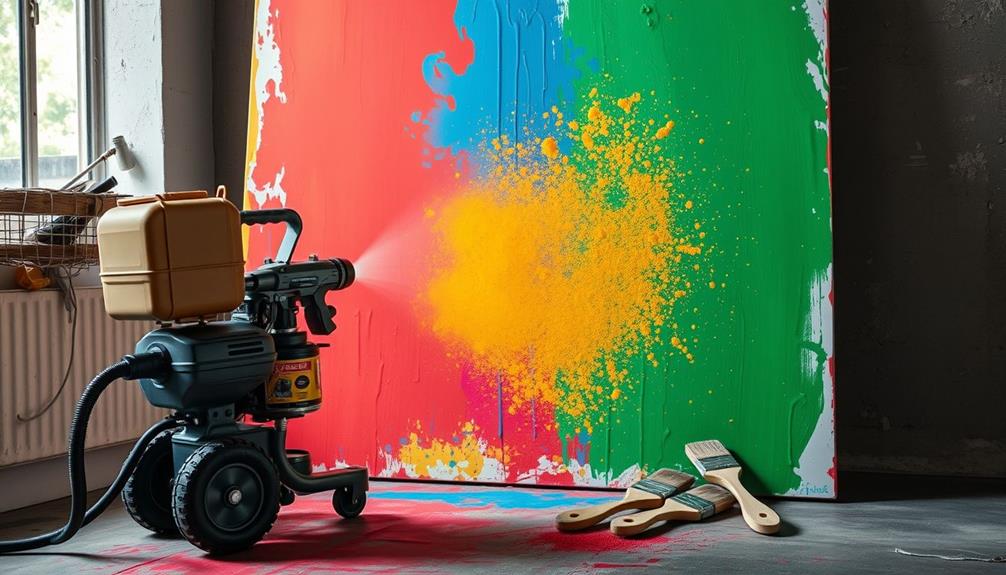
Airless paint sprayers offer several advantages that make them a compelling choice for many painting projects. One of the biggest benefits is the significant reduction in application time. You can cover large areas up to 10 times faster than with traditional brushes, making them ideal for extensive projects. This efficiency means you can complete tasks in a fraction of the time, allowing you to tackle more jobs or enjoy your finished space sooner.
Additionally, they're particularly useful for achieving a smooth finish, similar to the benefits seen with garage door openers that enhance home security and aesthetics.
Moreover, airless sprayers provide a smooth finish without brush marks, enhancing modern aesthetics and textures. They excel at reaching hard-to-access areas, ensuring thorough coverage even in corners and intricate designs, which can be a challenge with traditional brushes.
While you'll use about 33% more paint due to atomization, the efficiency in application often balances out the increased paint costs, especially in larger projects. With proper technique, you can achieve full coverage in fewer coats, saving both time and labor compared to applying multiple layers with brushes.
Disadvantages of Airless Sprayers
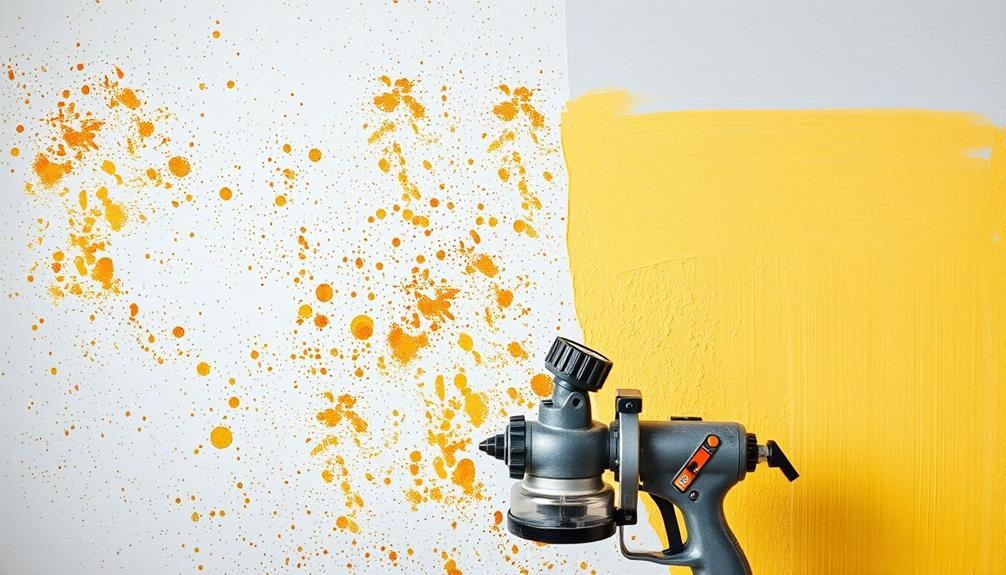
While airless sprayers can speed up the painting process, they come with significant downsides.
You'll need to invest time in extensive prep work to manage overspray and guarantee proper cleanup, which can be quite a hassle.
Additionally, using tools like the Graco FFLP Fine Finish Low Pressure Reversible Tip can enhance control but still requires meticulous preparation.
Plus, these sprayers often consume more paint, leading to increased costs and waste.
Overspray and Cleanup Challenges
Using an airless paint sprayer can lead to significant overspray, which often lands on unintended surfaces, creating a cleanup headache. The fine mist produced by these sprayers can result in paint particles drifting away, especially in windy conditions, complicating your cleanup efforts.
| Challenge | Airless Paint Sprayer | Traditional Paint Brushes |
|---|---|---|
| Overspray | High, often widespread | Minimal, controlled application |
| Cleanup Time | Time-consuming, requires disassembly | Quick and straightforward |
| Respirators Needed | Yes, for health safety | No, generally safe |
| Paint Consumption | Up to 33% more due to waste | Efficient, minimal loss |
Moreover, the cleanup process is often more involved than with traditional paint brushes. You'll need to disassemble and clean the sprayer to prevent clogs, which can be quite tedious. The increased paint consumption not only raises costs but also contributes to waste. So, if you're considering an airless sprayer, be sure to factor in the potential challenges of overspray and cleanup, and don't forget your respirators and protective gear for safety!
Higher Paint Consumption Rate
When it comes to paint consumption, airless paint sprayers can be a costly choice for your project. These sprayers typically use about 33% more paint than traditional brush applications because the atomization process disperses more paint into the air.
This can be particularly relevant when pondering the aesthetics of your space, as simple changes can elevate overall aesthetics in your home. This means that while you might save time and labor, your project costs could increase considerably due to the higher paint consumption.
With airless sprayers, you'll find that approximately 1 gallon of paint only covers 150-200 square feet, compared to 400 square feet with a brush. This disparity highlights the potential for paint waste, especially with the overspray generated by sprayers.
Wind can exacerbate this issue, leading to a paint loss of up to 25%. As you weigh your options, it's essential to reflect on how this excess paint disperses into the environment rather than landing on your intended surface.
Ultimately, while airless sprayers offer speed and efficiency, the higher paint consumption and associated project costs may not make them the best choice for every job.
Extensive Preparation Required
Preparing for a painting project with an airless sprayer means you'll face extensive setup tasks before you even start. Unlike traditional brushes, which require minimal prep, airless sprayers demand thorough surface preparation.
You'll need to mask and cover surrounding areas to prevent overspray, which can greatly increase your setup time. This extra effort is vital; inadequate preparation can lead to uneven adhesion and poor paint performance. Additionally, it's important to verify that the space is clean and free of dust, similar to how one would prepare for a home cleaning service to guarantee ideal results.
You'll have to lay down drop cloths and protective coverings for furniture and floors, adding to the overall time and effort you invest in the project.
If you're working outdoors, be aware that windy conditions can complicate things further, as paint drift can occur and ruin nearby surfaces. These extensive preparation steps can deter many DIY enthusiasts who might prefer quicker, less labor-intensive methods.
Ultimately, while airless sprayers offer benefits like a smooth finish, the extensive preparation required can make them less appealing when compared to the straightforward approach of traditional brushes. Be ready to commit time to setup if you choose to go this route.
Benefits of Traditional Brushes
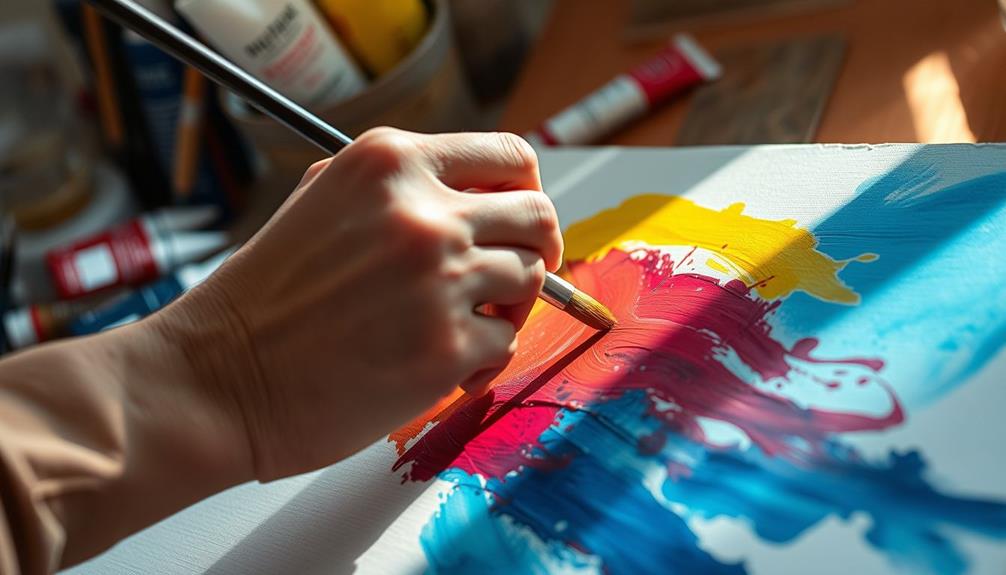
Traditional paint brushes offer unmatched control during application, making them perfect for tackling intricate details and hard-to-reach areas. When you use a brush, you can achieve precise work that allows for careful manipulation of paint, ensuring that every stroke counts. This level of control is particularly beneficial when dealing with complex patterns or textures.
Additionally, using traditional tools can create an emotional connection to your work, similar to how pets show affection to their owners, as both require a thoughtful approach and personal touch emotional attachment in cats.
Another advantage is that brushes typically allow for a thicker paint application. This can enhance durability and result in better adhesion to surfaces compared to spray methods. You'll find that brush strokes can create a more textured finish, adding character to your project, especially on uneven surfaces.
Additionally, traditional brushes are a cost-effective choice. The initial investment in brushes is generally lower than that of airless paint sprayers, making it easier on your wallet.
Plus, using brushes minimizes the risk of overspray, which not only reduces cleanup time but also protects surrounding surfaces from unintended paint application.
Drawbacks of Traditional Brushes

While traditional brushes have their merits, they come with significant drawbacks.
You'll find the application process can be time-consuming, often requiring multiple coats to achieve full coverage. This can be particularly frustrating when trying to maintain a cohesive look, as seen in popular farmhouse decor trends that emphasize clean, even finishes.
Plus, without careful technique, you risk brush marks that can ruin your finish, especially on textured surfaces.
Time-Consuming Application Process
When you pick up a paintbrush, you mightn't realize just how time-consuming the application process can be. Unlike airless sprayers, which can greatly speed up your project, traditional brush painting often draws out project durations.
Consider these factors:
1. Multiple Coats: For ideal coverage, you typically need to apply at least two coats of paint. This not only doubles your time but also requires a drying period in between, stretching your project over several days.
The same principle applies in heating systems, where heat pump failures can lead to prolonged project timelines for heating or cooling.
2. Attention to Detail: Traditional painting methods demand careful attention to avoid imperfections, which can lead to further touch-ups and corrections. This meticulousness is necessary to achieve a satisfactory finish, but it adds to the overall time commitment.
3. Labor-Intensive: The manual labor involved in brush painting is substantial. You'll find yourself investing hours, if not days, into what could be accomplished in a fraction of the time with airless sprayers.
Risk of Brush Marks
Brush marks can be a frustrating reality when using traditional paint brushes, especially if precision isn't your strong suit. When you're trying to achieve a smooth finish, the risk of brush marks increases, particularly on textured surfaces. Achieving consistent coverage on these surfaces requires not just skill but also careful technique, which can be a challenge for many.
Additionally, just as a vacuum with a self-cleaning mechanism can enhance performance by reducing hair wrap, employing the right painting tools and techniques can minimize the chances of brush marks.
Over-brushing can further complicate things, thinning out the paint and reducing the durability of your finish, while also increasing the likelihood of those pesky brush marks. Plus, since brush painting is generally a slower process, you might find that the paint begins to dry before you've had a chance to apply it evenly, leading to an uneven application.
Using high-quality brushes can help mitigate some of these issues, but even seasoned painters often struggle to achieve the flawless results that spray painting provides. In contrast to the efficiency of spray painting, traditional paint brushes can leave you grappling with the imperfections of brush marks, making it harder to achieve that perfect, smooth finish you desire.
Limited Coverage Efficiency
Achieving a smooth finish with traditional paint brushes often comes at the cost of limited coverage efficiency. When you opt for traditional brushes, you might find yourself covering around 400 sq ft per gallon on prepared surfaces.
In contrast, airless paint sprayers can cover 150-200 sq ft more effectively, which can considerably impact your labor time on larger projects. This efficiency can be likened to the design thinking approach, as it emphasizes user-centered solutions and can streamline your painting process.
Here are three key drawbacks of traditional brushes regarding coverage:
- Time-Consuming Application: You may need multiple coats to achieve full coverage, especially on textured surfaces, increasing overall labor time.
- Visible Brush Strokes: If you don't apply the paint carefully, you risk ending up with visible brush strokes, which diminishes the finish quality compared to the smooth coat from a sprayer.
- Physical Fatigue: The labor-intensive nature of using brushes can lead to exhaustion, particularly on larger surfaces or ceilings. Airless paint sprayers offer a more ergonomic solution, allowing you to paint efficiently without straining.
Ultimately, if you value efficiency and quality, the paint sprayer vs traditional brushes debate leans heavily in favor of airless paint sprayers.
Comparing Efficiency and Quality
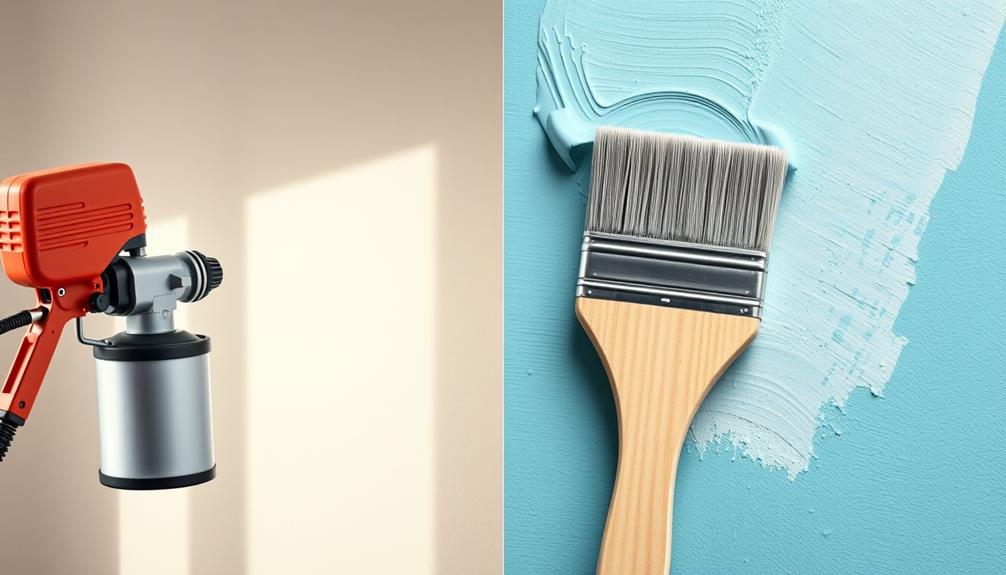
Efficiency and quality are essential factors in any painting project, and choosing between an airless paint sprayer and traditional paint brushes can greatly impact both.
An airless paint sprayer allows you to cover large areas much faster, often completing a paint job in half the time compared to brushes. This rapid application boosts efficiency, making it a go-to for those looking to finish quickly.
However, it's crucial to recognize that sprayers typically use about 33% more paint due to the atomization process, which can affect your material costs.
On the quality side, airless sprayers deliver a smooth finish without the brush marks often left by traditional paint brushes. This feature is especially appealing for modern aesthetics.
Professional painters often recommend a combination of both methods: using the sprayer for quick coverage and reserving brushes for detailed work. This approach maximizes efficiency while ensuring high-quality results.
Cost Analysis and Considerations
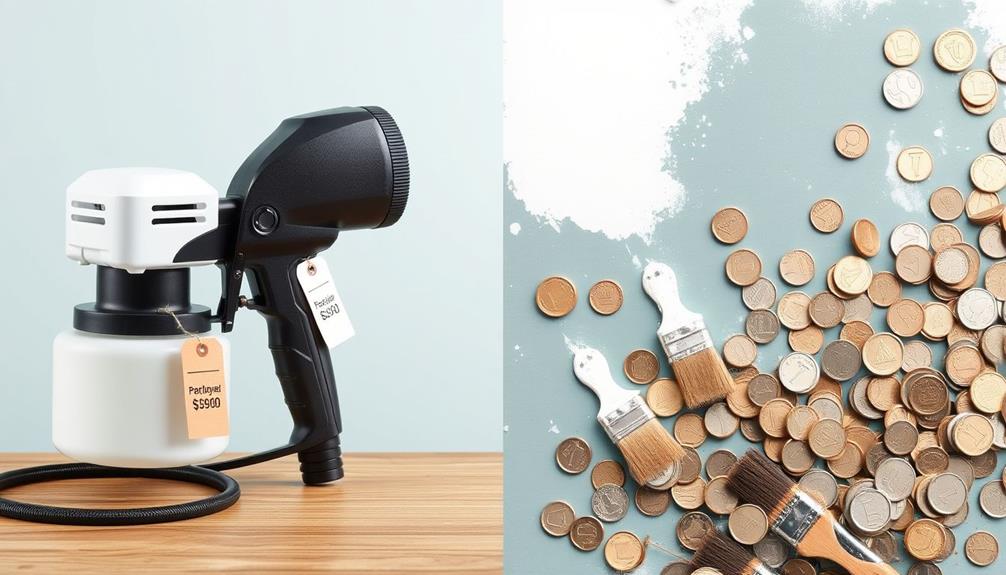
When you're weighing the costs of an airless paint sprayer versus traditional paint brushes, it's important to contemplate both initial investments and potential long-term savings.
While airless sprayers typically demand a higher initial investment, often starting around $200, brush painting requires much lower upfront costs. However, your choice can affect your overall budget in the long run.
Consider these key factors in your cost analysis:
- Labor Costs: Spray painting can markedly reduce the time spent on a project, which may lead to lower labor costs if you're hiring professionals.
- Price Advantage: Average quotes for exterior painting show that spray painting can cost around $2700, compared to approximately $3500 for brush and roller methods.
- Paint Usage: Although sprayers can use up to 33% more paint due to atomization, controlled brush application may minimize waste, impacting your total expenditure.
Ultimately, while the initial investment for sprayers is higher, their efficiency and potential price advantage may yield substantial savings over time.
Weigh these considerations carefully to make the best decision for your painting project.
Impact on Paint Consumption
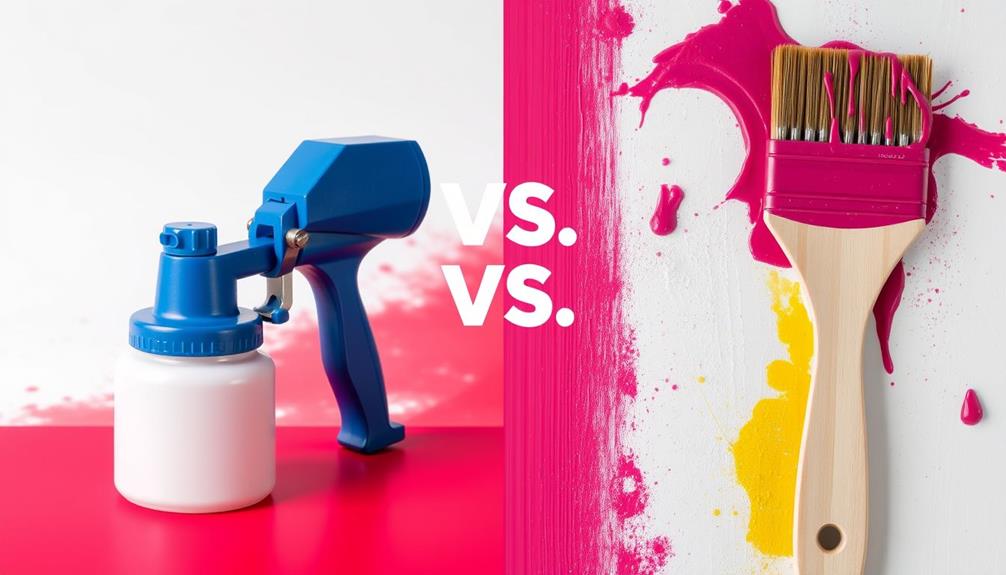
The impact on paint consumption varies greatly between airless paint sprayers and traditional brushes. Airless paint sprayers typically use about 33% more paint than traditional brushes due to the atomization process, which can lead to overspray and paint loss.
While sprayers cover approximately 150-200 square feet per gallon, you'll find that traditional brushes can cover around 400 square feet on well-prepared surfaces. This means brushes are often more efficient regarding paint consumption.
Additionally, windy conditions can exacerbate paint loss from sprayers by up to 25%, further affecting your overall paint consumption. Sprayers may also require extra paint to account for uneven coverage or streaking, often necessitating multiple coats for best results.
On the other hand, using traditional brushes allows for a more controlled application, greatly reducing waste. This is especially beneficial when working in detailed areas or on textured surfaces, where precision is key.
Tips for Choosing the Right Method
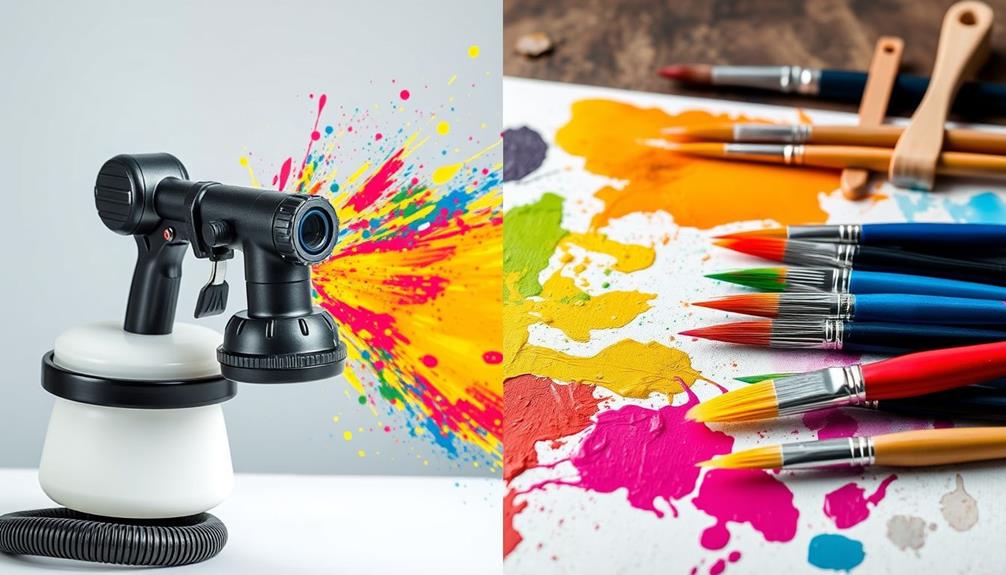
Choosing the right painting method can greatly impact your project's outcome. When deciding between an airless paint sprayer and traditional brushes, consider these key factors:
1. Project Size: If you're tackling large areas, a paint sprayer can drastically reduce application time.
For smaller projects, a brush or roller gives you better precision and control.
2. Surface Texture: Smooth surfaces benefit from the even coverage of sprayers, whereas textured surfaces often require brushes to guarantee you don't miss any crevices during prep work.
3. Budget Considerations: While airless sprayers might set you back around $200 initially, they can save you time and labor costs on extensive projects.
However, remember that spraying generally consumes about 33% more paint due to atomization, which can affect your overall budget.
Don't forget about the learning curve! Mastering a paint sprayer takes practice to prevent drips and uneven application.
For those less experienced in painting, traditional brushes might be the easier option.
Frequently Asked Questions
Is It Better to Spray or Brush Interior Paint?
When deciding between spraying or brushing interior paint, consider your project's size and detail. Spraying's faster and smoother for large areas, while brushing offers precision for intricate spots. Choose based on your specific needs and preferences.
What Are the Disadvantages of Airless Paint Sprayer?
When using an airless paint sprayer, you'll face overspray issues, higher paint consumption, and the need for extensive surface preparation. Plus, mastering the technique takes practice to avoid uneven coverage and streaks.
Is It Better to Use Airless Paint Sprayer?
When you consider using an airless paint sprayer, you'll save time, enjoy a smoother finish, and tackle larger areas efficiently. However, you'll face higher paint usage and more extensive cleanup. Weigh your project's needs carefully.
What Are the Benefits of Airless Paint Sprayer Over Brushing and Rolling?
Using an airless paint sprayer saves you time, covering large areas quickly and providing a smooth finish. It reaches tight spaces easily, ensuring extensive coverage, even if it uses a bit more paint initially.
Conclusion
When it comes to choosing between airless paint sprayers and traditional brushes, it's like deciding between a race car and a bicycle. Each method has its own strengths and weaknesses, so it really boils down to your specific needs. If speed and efficiency are your priorities, airless sprayers might be the way to go. However, if precision and control matter more, traditional brushes could be your best bet. Ultimately, pick the one that best suits your painting project.
